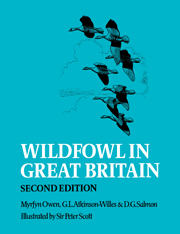Book contents
- Frontmatter
- Contents
- List of location maps
- Foreword by William Wilkinson
- Acknowledgements
- Conventions and abbreviations
- Part I Introduction
- Part II The survey of wildfowl habitat and distribution
- Part III Species accounts
- Part IV The conservation of wildfowl and their habitats
- Conclusion
- References
- Indexes
Foreword by William Wilkinson
Published online by Cambridge University Press: 04 August 2010
- Frontmatter
- Contents
- List of location maps
- Foreword by William Wilkinson
- Acknowledgements
- Conventions and abbreviations
- Part I Introduction
- Part II The survey of wildfowl habitat and distribution
- Part III Species accounts
- Part IV The conservation of wildfowl and their habitats
- Conclusion
- References
- Indexes
Summary
As one who, in his time, has been a wildfowl counter, both in Britain for the Wildfowl Trust and abroad for the International Waterfowl Research Bureau, it is a particular pleasure to welcome the completion of this Domesday Book of the wildfowl and their wetland habitats. Since its predecessor was published in 1963, the range and bulk of data have greatly increased, thanks to the efforts of several thousand dedicated volunteer workers. The Wildfowl Trust, supported by the Nature Conservancy Council, has played the central role in collecting and analysing the data, but their sister organisations, the British Trust for Ornithology and the Royal Society for the Protection of Birds, have been more than supportive, as have been the Naturalists’ Trusts and Ornithological Societies throughout the country. Indeed this is a very British achievement, basically one of free enterprise but underpinned by a, relatively modest, funding from Government sources.
The vulnerability of wetlands to modern technological developments was recognised by the drawing up in 1971 at Ramsar, in Iran, of the Convention on Wetlands of International Importance Especially as Waterfowl Habitat. With 38 countries now adhering to the convention, and more than 300 wetlands covering some 19 million hectares afforded special protection, the international effort has clearly had considerable success. In the United Kingdom 19 wetlands of international importance have been designated for the Ramsar List and our aim is to extend that status to cover the 132 which satisfy the agreed criteria. The data presented in this book are of crucial importance in this task.
- Type
- Chapter
- Information
- Wildfowl in Great Britain , pp. ix - xPublisher: Cambridge University PressPrint publication year: 1986



